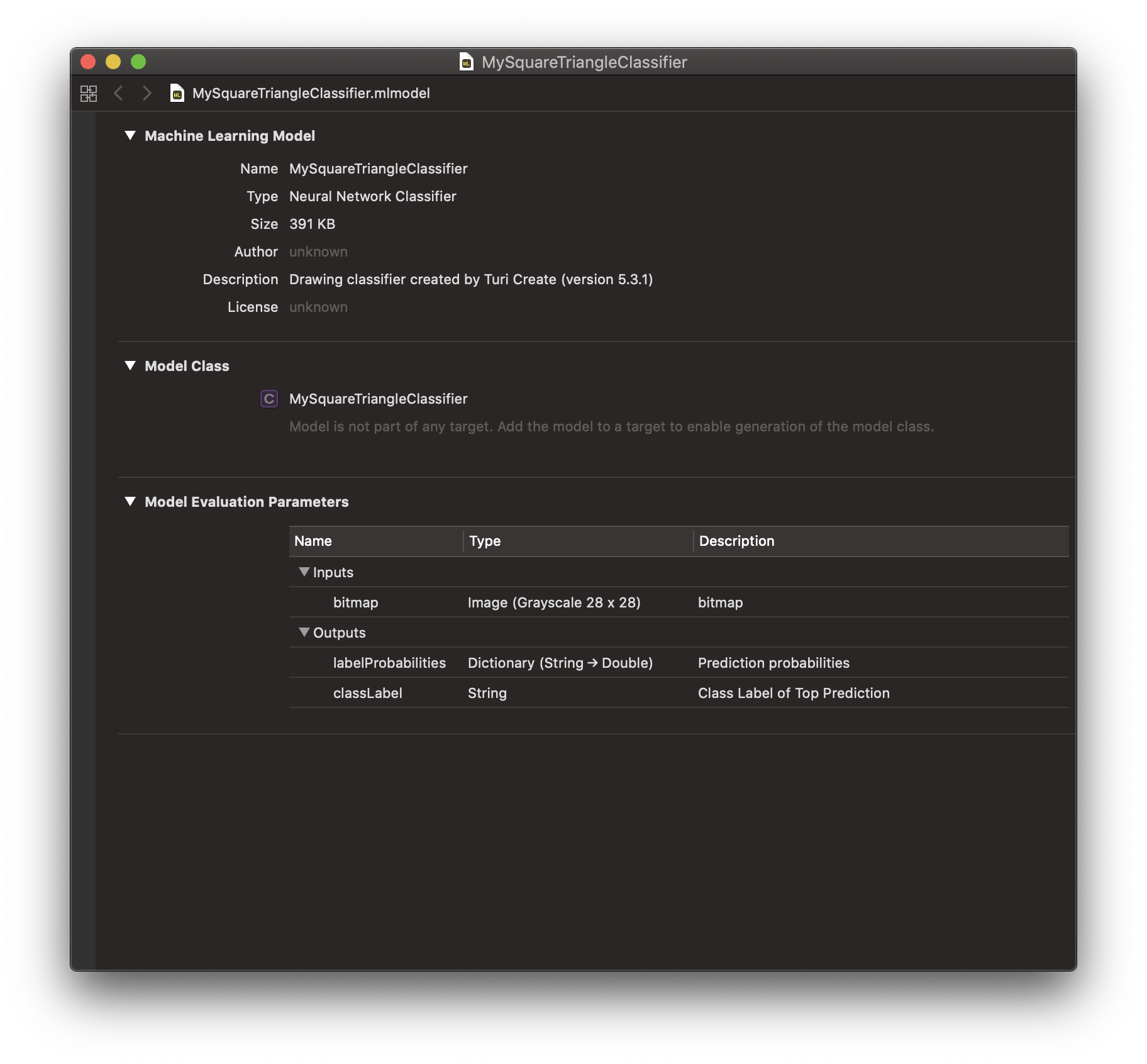Deploying to Core ML
Drawing Classifier models created in Turi Create can easily be deployed to Core ML.
You can export to Core ML in Turi Create 5.4 as follows:
model.export_coreml("MySquareTriangleClassifier.mlmodel")The Core ML Model should look like the following:

Drag and drop MySquareTriangleClassifier.mlmodel into your Xcode project and
add it to your app by ticking the appropriate Target Membership check box.
Inference
Making a prediction at inference time on device is easy! In this section, we go over your workflow depending on what input you may have in your app at inference time.
Using Bitmap Input
At inference time, if you have access to a bitmap and/or image that represents the drawing you want to classify, you can use the Vision framework to consume the exported Core ML model. Note that the image you provide to the Vision API must be a Grayscale Image.
let model = try VNCoreMLModel(for: MySquareTriangleClassifier().model)
let request = VNCoreMLRequest(model: model, completionHandler: { [weak self] request, error in
self?.processClassifications(for: request, error: error)
})Using Stroke-Based Drawing Input
On the other hand, if you have access to raw stroke-based drawing data at inference time, you will first have to convert it to a Grayscale Bitmap and then use the Vision framework so the Core ML model can consume images at inference time.
First, convert your stroke-based drawing into a member of the following Drawing class using the methods that the following Drawing class exposes.
import Foundation
import CoreGraphics
class Drawing {
var drawing: NSMutableArray
var stroke: NSMutableArray
var min_x: CGFloat
var min_y: CGFloat
var max_x: CGFloat
var max_y: CGFloat
init() {
drawing = NSMutableArray()
stroke = NSMutableArray()
min_x = CGFloat.greatestFiniteMagnitude
max_x = 0.0
min_y = CGFloat.greatestFiniteMagnitude
max_y = 0.0
}
func pointCount(stroke i:Int) -> Int {
let corresponding_stroke = drawing.object(at:i) as! NSArray
return corresponding_stroke.count
}
func strokeCount() -> Int {
return drawing.count
}
func point(stroke i:Int, point j:Int) -> CGPoint {
let corresponding_stroke = drawing.object(at:i) as! NSArray
let answer = corresponding_stroke.object(at:j) as! CGPoint
return answer
}
func stroke(index i:Int) -> NSMutableArray {
return drawing.object(at: i) as! NSMutableArray
}
func add(point P:CGPoint) {
let x = P.x
let y = P.y
min_x = min(x, min_x)
max_x = max(x, max_x)
min_y = min(y, min_y)
max_y = max(y, max_y)
stroke.add(P)
}
func endStroke() {
let new_stroke = NSMutableArray()
new_stroke.addObjects(from: stroke as! [Any])
drawing.add(new_stroke)
stroke.removeAllObjects()
}
}
Once your stroke-based drawing is a member of the above Drawing class, call the
rasterize function on it to build a 28x28 grayscale bitmap.
The Core ML model can then run inference on this bitmap via the Vision framework
as described above under "Using Bitmap Input".
The code snippet containing rasterize and its helper,
normalize are provided below.
func normalize(drawing D:Drawing) -> Drawing {
let new_drawing = Drawing()
for i in 0..<D.strokeCount() {
for j in 0..<D.pointCount(stroke: i) {
let current_point = D.point(stroke: i, point: j)
var new_x, new_y : CGFloat
if (D.max_x == D.min_x) {new_x = D.min_x}
else {
new_x = (current_point.x - D.min_x) * 255.0 / (D.max_x - D.min_x)
}
if (D.max_y == D.min_y) {new_y = D.min_y}
else {
new_y = (current_point.y - D.min_y) * 255.0 / (D.max_y - D.min_y)
}
let new_point = CGPoint(x: new_x, y: new_y)
new_drawing.add(point: new_point)
}
new_drawing.endStroke()
}
return new_drawing
}
func rasterize(drawing stroke_based_drawing:Drawing) -> CGImage {
let D = normalize(drawing: stroke_based_drawing)
let grayscale = CGColorSpaceCreateDeviceGray()
let intermediate_bitmap_context = CGContext(
data:nil, width:256, height:256, bitsPerComponent:8, bytesPerRow:0,
space:grayscale, bitmapInfo:CGImageAlphaInfo.none.rawValue)
intermediate_bitmap_context?.setStrokeColor(
red: 1.0, green: 1.0, blue: 1.0, alpha: 1.0)
let transform = CGAffineTransform.identity
let path = CGMutablePath()
for strokeIndex in 0..<D.strokeCount() {
let stroke = D.stroke(index: strokeIndex)
let startPoint = D.point(stroke: strokeIndex, point: 0)
path.move(to: startPoint, transform: transform)
for point in stroke {
path.addLine(to: point as! CGPoint, transform: transform)
}
}
intermediate_bitmap_context?.setLineWidth(20.0)
intermediate_bitmap_context?.beginPath()
intermediate_bitmap_context?.addPath(path)
intermediate_bitmap_context?.strokePath()
let intermediate_image = intermediate_bitmap_context?.makeImage()
let final_bitmap_context = CGContext(
data:nil, width:28, height:28, bitsPerComponent:8, bytesPerRow:0,
space:grayscale, bitmapInfo:CGImageAlphaInfo.none.rawValue)
let final_rect = CGRect(x: 0.0, y: 0.0, width: 28.0, height: 28.0)
final_bitmap_context?.draw(intermediate_image!, in: final_rect)
return (final_bitmap_context?.makeImage())!
}